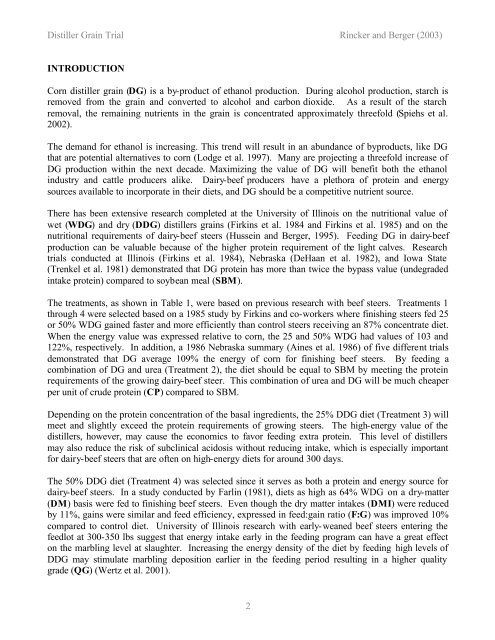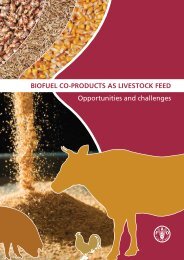Distillers Grains Feeding Recommendations. - Distillers Grains By ...
Distillers Grains Feeding Recommendations. - Distillers Grains By ...
Distillers Grains Feeding Recommendations. - Distillers Grains By ...
Create successful ePaper yourself
Turn your PDF publications into a flip-book with our unique Google optimized e-Paper software.
Distiller Grain Trial Rincker and Berger (2003)INTRODUCTIONCorn distiller grain (DG) is a by-product of ethanol production. During alcohol production, starch isremoved from the grain and converted to alcohol and carbon dioxide. As a result of the starchremoval, the remaining nutrients in the grain is concentrated approximately threefold (Spiehs et al.2002).The demand for ethanol is increasing. This trend will result in an abundance of byproducts, like DGthat are potential alternatives to corn (Lodge et al. 1997). Many are projecting a threefold increase ofDG production within the next decade. Maximizing the value of DG will benefit both the ethanolindustry and cattle producers alike. Dairy-beef producers have a plethora of protein and energysources available to incorporate in their diets, and DG should be a competitive nutrient source.There has been extensive research completed at the University of Illinois on the nutritional value ofwet (WDG) and dry (DDG) distillers grains (Firkins et al. 1984 and Firkins et al. 1985) and on thenutritional requirements of dairy-beef steers (Hussein and Berger, 1995). <strong>Feeding</strong> DG in dairy-beefproduction can be valuable because of the higher protein requirement of the light calves. Researchtrials conducted at Illinois (Firkins et al. 1984), Nebraska (DeHaan et al. 1982), and Iowa State(Trenkel et al. 1981) demonstrated that DG protein has more than twice the bypass value (undegradedintake protein) compared to soybean meal (SBM).The treatments, as shown in Table 1, were based on previous research with beef steers. Treatments 1through 4 were selected based on a 1985 study by Firkins and co-workers where finishing steers fed 25or 50% WDG gained faster and more efficiently than control steers receiving an 87% concentrate diet.When the energy value was expressed relative to corn, the 25 and 50% WDG had values of 103 and122%, respectively. In addition, a 1986 Nebraska summary (Aines et al. 1986) of five different trialsdemonstrated that DG average 109% the energy of corn for finishing beef steers. <strong>By</strong> feeding acombination of DG and urea (Treatment 2), the diet should be equal to SBM by meeting the proteinrequirements of the growing dairy-beef steer. This combination of urea and DG will be much cheaperper unit of crude protein (CP) compared to SBM.Depending on the protein concentration of the basal ingredients, the 25% DDG diet (Treatment 3) willmeet and slightly exceed the protein requirements of growing steers. The high-energy value of thedistillers, however, may cause the economics to favor feeding extra protein. This level of distillersmay also reduce the risk of subclinical acidosis without reducing intake, which is especially importantfor dairy-beef steers that are often on high-energy diets for around 300 days.The 50% DDG diet (Treatment 4) was selected since it serves as both a protein and energy source fordairy-beef steers. In a study conducted by Farlin (1981), diets as high as 64% WDG on a dry-matter(DM) basis were fed to finishing beef steers. Even though the dry matter intakes (DMI) were reducedby 11%, gains were similar and feed efficiency, expressed in feed:gain ratio (F:G) was improved 10%compared to control diet. University of Illinois research with early-weaned beef steers entering thefeedlot at 300-350 lbs suggest that energy intake early in the feeding program can have a great effecton the marbling level at slaughter. Increasing the energy density of the diet by feeding high levels ofDDG may stimulate marbling deposition earlier in the feeding period resulting in a higher qualitygrade (QG) (Wertz et al. 2001).2
















